|
1.
CENTRAL/ WEST AFRICA
Asia market takes price leadership from Europe
As reported in previous issues, demand and log prices in West Africa have been increasingly driven by Asian
buyers over the past months, leaving Europe trailing behind for many of the currently traded major species.
There are, of course, differences in demand patterns with European buyers tending to stick firmly to old favourites
species while China and India buy a wide range of species, including those with low or no demand in
Europe.
The steady decline in plywood production in Europe and the equally fast closure of primary log sawmills over the
years have brought a fundamental shift in trade patterns. In addition, the fall in log availability in South East Asia
has moved demand emphasis towards West Africa. Up until recently, log prices for Europe were normally
higher than those for China. However, this situation has reversed in the past few months, with much increased
competition from Indian buyers who have moved strongly into the market. The TTM Report will from
now report on log prices for the Asian market.
In late June, once again, there were selective price increases, notably for belli, movingui, tali and sapele
logs. The firm demand for sapele logs has continued, resulting in price increases of about euro15 per m3 for LM
and BC/C grades and euro7 per m3 for B grade.
Lumber prices stable amid very firm demand
No further price rises were reported for West Africa sawnwood through mid-June, though the market remains
very firm with mills working close to capacity on existing contracts. Enquiries for sawn lumber and
processed products are now coming from traders in South East Asia that are finding it difficult to source from their
traditional mills in Indonesia and Malaysia. Up to now, West African lumber prices have not risen as steeply as
those from Asia, but demand from Europe is good and
production capacity in the West African region is unlikely to be sufficient to supply the volumes requested.
Some traders and agents have reported that mills were not responding to enquiries or unable to make offers for
new business for the time being.
Peeler veneer prices are stagnant due to fierce competition in the European market. This situation could
in time back up the supply pipeline and affect peeler log prices, though there is no sign of this at present.
Congo's CIB Kabo obtains FSC Certificate
Congolaise Industrielle des Bois' (CIB, subsidiary of the Danish DLH group) Kabo Forest
Management Unit (FMU) has gained FSC certification under the SGS Qualifor Programme. Located in northern Republic of
Congo, the Kabo FMU covers 296,000 hectares and had its forest management plan approved by the Congolese
authorities in March 2006. CIB intends to continue
efforts to have its remaining FMUs, totalling 1.3 million ha, FSC certified in the near future.
UN lifts import ban on timber products from Liberia
At its last meeting on 20 June, the UN Security Council (UNSC) decided not to renew its import ban on round log
and timber products from Liberia. However, it warned that the ban could be reinstated if appropriate forestry
legislation was not passed in 90 days. On the other hand, the UNSC extended for six months its ban on imports of
rough diamonds from the West African nation since the
situation in Liberia continued to pose a threat to international peace and security. Both the diamond and
timber bans were imposed in 2003, after the Council accused the government of fueling conflict in the region
through an illicit trade in arms for diamonds and timber.
A UN expert panel reported this month that logging, once resumed, could yield as much as $80 million in sales a
year, with $15 million of that going to the Liberian government. The Council commended Liberia's
President Ellen Johnson-Sirleaf for her commitment to transparent management of the country's forestry
resources (see TTM 11:5), and took note of her recent
announcement of a moratorium on timber exports and new timber concessions, pending the passage of
appropriate forestry legislation.
Liberia classifies forests for protection and logging
Liberia had classified some forest areas that are suitable for commercial logging or protection, John Woods,
Director of the Forestry Development Authority (FDA), informed. Liberia had proposed 1.1 million ha for
protection (about 12% of the country's territory).
Mr. Woods said that after all timber concession agreements under the previous government were declared
null and void (see TTM 11:5), the government planned to manage the resource on a sustainable basis . The plans
were to harvest a maximum of 750,000 m3 of timber per year, which should bring annual revenues of about $15
million to the government and around 7,000 new jobs for
the forestry industry. The FDA's personnel would be reduced from 510 to 350 to gain efficiency. Liberian
President Ellen Johnson-Sirleaf informed that the government was aiming to raise a $30 million fund to
protect its rainforests, which still covered about 50% of the Liberian territory.
Cameroon and France sign first debt-for-nature swap
France and Cameroon signed the first ever Central African debt-for-nature swap on 22 June, which would
result in at least $25 million over the next five years being invested in protecting parts of the Congo River
Basin, the world¡¯s second largest tropical forest. The agreement was part of France¡¯s Debt Development
Contract (C2D) under the Heavily Indebted Poor Countries initiative (HIPC). The goal of the C2D was to
provide full debt relief of the concessional loans (estimated at $4.6 billion) France contracted to 22
eligible countries.
The agreement requires Cameroon to earmark funds in four different sectors: education, health, infrastructure
and natural resources. This is the first C2D agreement allocating funds to natural resources. The investment
funds will be used to better manage protected areas, wildlife and forest production and increase community
forest resources and research capacity.
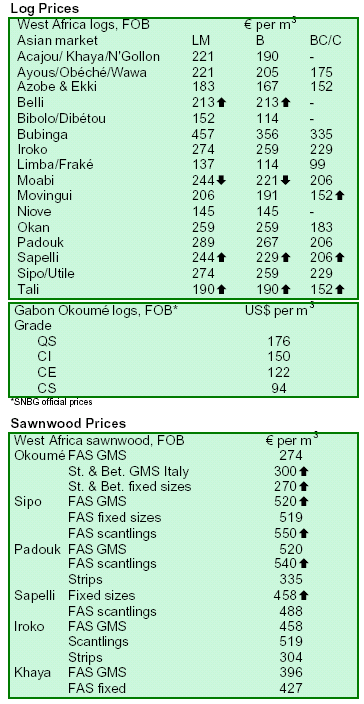
Congo opens up new FMU for tender
The Republic of Congo is inviting bid proposals for Ntombo forest management unit (FMU), located in the
Kouilou department, Sud 1 Pointe-Noire. Ntombo covering 93,000 ha and with an allowable annual cut
(AAC) to be agreed by the parties. The FMU is for logging and timber processing according to the country¡¯s
forest regulations. Applications will be received until 4 August. Further details can be obtained from Mr. Jacques
KANWE (jkanwe@yahoo.fr).
2. GHANA
Ghana regulates mining in forest reserves
Ghana's Minister of Lands, Forestry and Mines, Professor Dominic Fobih, briefed the Parliament about
mining operations in the country's forest reserves, saying that only proper mining would be allowed in the reserves.
He said all other activities and the construction of infrastructure related to mining would be located outside
the reserve.
In 1996, the Ministry considered banning mineral exploration in forest reserves due to growing concern on
the depletion of forest reserves. However, some companies had already made substantial investment and
reached advanced stages in mineral exploration in some of the forest reserves without contravening any terms of
the permit granted. The Ministry set out "Operational
Guidelines for Mineral Exploration in Forest Reserves"in September 1997 to regulate exploration activities in
forest reserves. The guidelines were complemented with the "Environmental Guidelines for Mining in Productive
Forest Reserve in Ghana" in May 2001. The Minister revealed that five mining companies were operating in
forest reserves . He informed that these companies were
expected to reclaim the areas they mine and that reclamation bonds were to be posted by the companies to
ensure that in the event that an investor would not carry out the required reclamation, funds would be available
for the Government to do so.
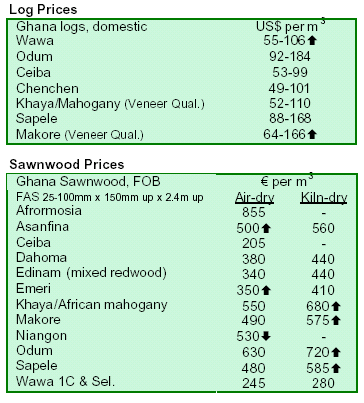

3.
MALAYSIA
Europeans seek supplies elsewhere in Asia
After a prolonged boom period when timber prices broke decade-long records, prices seem to be cooling down in
an over-heated market. While the UK, Germany and the Netherlands continue to be the main export markets for
Malaysian timber products, European buyers are shopping around the region for cheaper alternative
sources of supply. European traders are not only taking a second look at Indonesian suppliers but are increasingly
seen to be active in Vietnam, Laos and Cambodia.
With the recent lifting of the trade sanction against Liberian timber products by the UN Security Council,
European traders are progressively becoming more active in that country as well. A number of European traders
have not only viewed the Malaysian market as highly speculative, but also one that is void of any long-term
solution to its shortage of raw material. Moreover, with a
harvesting-to-processing period of up to 3 months for Malaysian timber products, buyers are consolidating their
inventory, noting that the autumn season is only a few months away. The mitigating factor for the Malaysian
market is that India, China and Middle -Eastern countries
are seen to be replacing the EU as major buyers of Malaysian timber products.
Meanwhile, the domestic market continues in doldrums. While the growth of the national economy is said to be
holding at 5%, the local construction and housing industry seems to have lost all stream. A number of
tenders for major infrastructural projects closed since early 2005 are yet to be awarded.
Minister urges resumption of rubber planting
The Minister of Plantation Industries and Commodities, Datuk Peter Chin Fah Kui, urged planters to resume
planting of natural rubber (NR). Rubberwood is the main raw material for the Malaysian furniture industry. Mr.
Chin said NR's price was expected to remain on the high side even if oil prices started to fall and stabilize. China's
expanding motor vehicle sector and India's manufacturing industry as well as lower output from
rubber producers are among the factors that are expected to keep NR prices up.
He urged plantation owners, especially those on hilly areas where it is difficult to plant oil palm, to plant
rubber. He also encouraged oil palm plantations in areas with unsuitable topography to be converted to rubber.
The increase in rubber planting would boost production of latex and rubberwood which were highly in demand,
he said. On palm oil, Mr. Chin said the cultivated areas were expected to increase to 4.5 million ha producing
15.5 million tonnes in 2007, up from 3.9 million ha
producing 15.4 million tonnes in 2005.
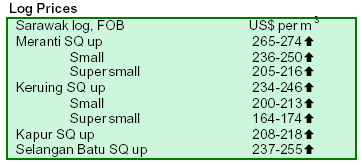
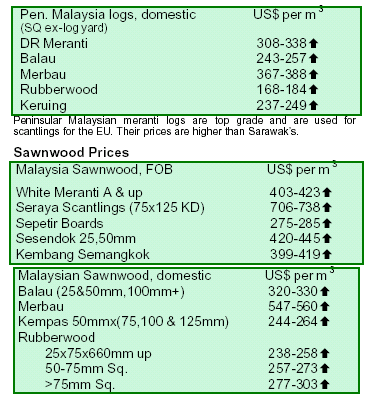
4.
INDONESIA
Prices surge amid active Chinese traders
Domestic prices of timber products remain stable in Indonesia while prices for the foreign market,
particularly for plywood and panel products, are edging up. Traders from China are seen to be increasingly active
in Indonesia. A number of traders from Singapore are also moving into the market.
Traders opt for efficient Singaporean ports
Singaporean traders are taking advantage of the fact that the Indonesian transportation infrastructure and port
facilities are often seen to be inefficient. Singaporean traders are purchasing Indonesian timber products for
storage at warehouses operated by the PSA (Port of Singapore Authority). The efficiency of the PSA system
permits Singaporean traders to market and ship timber products to China, Japan, Europe, USA and India, in
direct competition with Malaysian exporters.
Specifications of sawnwood authorized for export
The Indonesian government banned the export of rough sawnwood in October 2004 in order to revitalize its
domestic wood processing industry and tightened controls on exports of air dried sawnwood (see TTM
10:12). In February 2006, the Trade Minister informed that the regulation allowed wood producers to export
certain types of sawnwood (TTM 11:4). According to recent information, the sawnwood that could be exported
should:
¡¡¡¡ì¡¡ì have regularity of shape with parallel sides;
¡¡¡¡ì¡¡ì not be finger jointed;
¡¡¡¡ì¡¡ì have thickness of more than 6 mm;
¡¡¡¡ì¡¡ì have moisture content not more than 18%; and
¡¡¡¡ì¡¡ì be included in custom tariff code HS 4407.
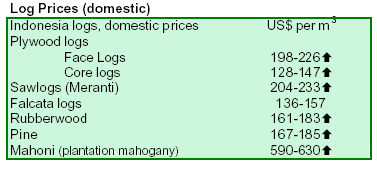
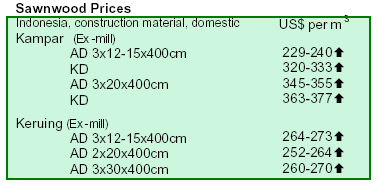
5.
MYANMAR
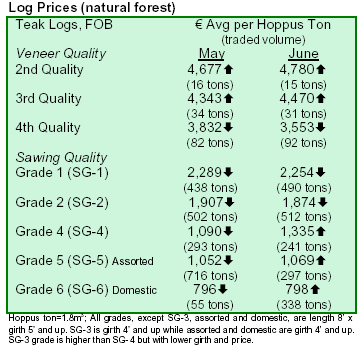
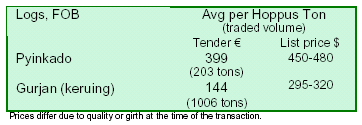
6. PAPUA
NEW GUINEA
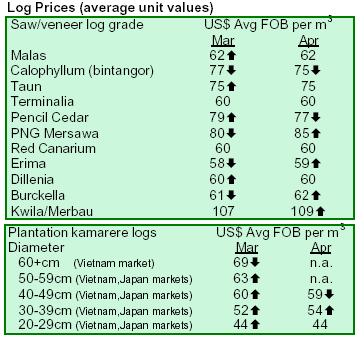
7.
BRAZIL
Strikes at IBAMA and customs hinder exports
IBAMA went on strike in early May on pension plans for retirees and career rights for employees. New shipments
were suspended as IBAMA was the entity authorizing timber transportation and exports. Only activities related
to deforestation controls were operating. According to the Lumber Union in Sinop, Mato Grosso, at least 50
exporting companies had products waiting to be exported. The Brazilian Association for Mechanically
Processed Timber (ABIMCI) got a judicial guarantee of the companies 'right to export their products despite the
strike. However, in Northern Mato Grosso, only nine companies are members of the association. Companies
claimed that the halt of shipments and contracts have caused them financial losses and damage in market
credibility.
The IBAMA strike was over in early June but traders
reported backlog of work holding up the dispatch of consignments which, in some instances, had been at the
docks for weeks awaiting shipment approval. Analysts say that it might take few weeks for transport to restart
and shipments to get back to normal.
This situation has been compounded by strikes at the
customs authorities in some ports, causing further delays in shipments. Storage at the ports was used at full
capacity, leading to the blocking of additional deliveries. Customs authorities were still on strike at the time of
preparation of this report.
Domestic prices fall sharply as US dollar recovers
Prices of wood products in Brazilian reais were largely unchanged in late June. Conversely, prices in US dollars
declined sharply by about 8% during the period due to the sudden depreciation of the Brazilian currency against
the US dollar. However, the trend reversed in the last week of June as the reais recovered against the US
currency.
Exports of solid wood continue downward trend
Exports of solid wood products continued to decline across the board, falling 14.4% to $301.9 million in May
2006, compared with the same month in 2005. Exports of pine sawnwood exports fell 23.5% to $23 million (down
31% to 105,700 m3). Tropical sawnwood exports plunged 40% to $31.7 million (down 40% to 93,400 m3),
compared with May 2005. Exports of pine plywood slipped 32% to $31.4 million (down 34% to 115,700 m3)
compared with the previous month. Exports of tropical
plywood decreased 40% and 51% to $15.8 million and 34,500 m3, respectively. Meanwhile, exports of furniture
fell 13% to $70.1 million, compared with May last year.
Analysts call for caution with exchange rates
Some forest sector analysts in Brazil have warned companies to be cautioned about recent developments in
the US economy and the great risk of wrong or premature decisions that may lead companies to further financial
losses . According to analysts, the forest sector in Brazil, mainly those dependent on exports such as the plywood
segment, runs the risk of being affected by the slowdown of the US economy. In particular, the burst of the house
bubble that supported US economy growth until recently, may have adverse impacts. Prices for pine plywood in the
USA have fallen to under $190 per m3 for 12mm and 15mm and about $200 per m3 for 18mm. These price
decreases have not been offset by an equivalent depreciation of the Brazilian currency. Analysts warned
companies not to be misled by short-lived depreciations of the reais and be well-informed before accepting price
cuts from suppliers.
Brazil establishes 3 new reserves in the Amazon
The Brazilian President decreed three new protected areas in the Amazon basin, placing 1.84 million ha of
rainforest off-limits for development. The areas include the 880,000 ha ¡¡ãCampos Amazonicos National Park¡¡Àlocated in southeast Amazonas and northeast Rondoia
states; the 830,00 ha extractive reserve of River Unini located in the northern Amazonas state; and the 133,000
ha extractive reserve Arapixi in southern Amazonas state. Extractive reserves are areas where local communities
can exploit the rainforest in a sustainable manner, harvesting its fruits, nuts and
rubber without logging.
According to the Minister of Environment, Ms. Marina
Silva, the National Park will contribute to preventing the expansion of deforestation from the State of Rondonia
into the State of Amazonas. The same approach was utilized when the Government created the National Park
of Juruema that contributed to preventing the expansion of deforestation from the State of Mato Grosso into the
State of Amazonas. Since taking office in 2002, the government has created 57 protected areas in the
Amazon preserving some 19.3 million ha of rainforest, the Environment Ministry said. The Governor of
Amazonas informed that the state had also created three reserves, namely: Reserve of River Madeira, Reserve of
River Juma and State Park of Matupi.
Par¡¡ì¢ hosts first sustainable forest district in Brazil
The federal government launched a plan to implement the so-called BR-163 Forest District, in western Par¡¡ì¢ in the
Amazon region. The plan was created last February as part of government measures to promote sustainable
development in the Amazon. According to the Ministry of
the Environment, the district has 19 million ha of forest across ten municipalities, of which 5 million ha will be
under sustainable management.
The district is expected to create 100,000 jobs and
sustainably produce 4.5 million m3 of wood a year with annual revenue of 1 billion reais. The district might also
produce 200 megawatts of energy. An annual grant plan considers the need to create conservation units and
settlements of local communities. A decree that will create the Management Commission of Public Forests for the
district will likely evaluate and define guidelines to forests administration. The agency will be formed by twenty-four
representatives from seven ministries, civil society organizations and the federal government.
System to monitor selective cutting in the Amazon
A system that will monitor selective cutting in the Brazilian Amazon forests will be launched shortly. Selective cutting is
the harv esting of selected species with commercial value, a
process so far not accounted for by the federal government. The system's methodology takes into account the affected
area and the intensity of harvesting, and relies on satellite images and a number of variables: vegetation, exposed land,
shadows and non-photosynthetic biomass.
The monitoring system was developed by a partnership
between the National Institute of Space Research (INPE), a Sao Paulo agency responsible for the annual estimation of
the deforestation in Amazonia, and the Amazon Institute of People and Environment (IMAZON), a
Para's research
organization. The Ministry of the Environment is to invest 1.4 million reais ($630,000) to implement the system. The
Ministry expects to use the system to monitor exploration concessions in public and private forests.
Brazil's SIPAM to monitor the Amazon
The eight member states of the Amazon Cooperation Treaty Organization (OTCA), Brazil, Bolivia, Colombia,
Ecuador, Guyana, Peru, Surinam, and Venezuela intend to use Brazil's Amazon Protection System (SIPAM) as
the basis for integrating their national forest monitoring programs. OTCA's Secretary-general Rosalia Arteaga
Serrano said that the exchange of technology and
information will be vital in fulfilling OTCA's and SIPAM's common institutional mission of integrated
management of the Amazon's natural resources. She added that it would help in forest supervision, especially
to detect illegal activities, such as burnings, trafficking in biodiversity and illegal removal of valuable wood.
OTCA was created in 1995 to promote mutual actions on behalf of the sustainable development of the Amazon
Basin.
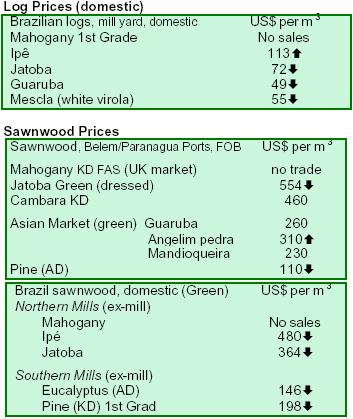
8. PERU
Government stimulates certified forest concessions
INRENA is granting 25% discount on concession fees to forest concessionaires that have been certified. Maderas
Peruanas S.A.C. (Mapesac), holder of a FSC certificate of a concession in the department of Ucayali (see TTM
11:7), was the first beneficiary of the new incentive. The incentive is renewable for up to five years. Mapesac, a
wood flooring manufacturer, exports its FSC certified
products to Europe, Japan and North America.
False forest conservationists caught logging illegally
INRENA has dismantled a network of false forest conservationists logging and trading logs illegally in San
Martin, northeast Peru. Loggers bought lands in this area for farming, reforestation or conservation purposes,
identifying themselves as members of the Flora and Wildlife Conservation Association of the Escalera Hill, a
legally registered NGO. They subsequently logged the area and sold the logs to mills.
Peruvian congress ratifies FTA
On June 28, the Peruvian congress approved the Free Trade Agreement (FTA) signed with the USA, amid
protests from some quarters. Previously, the Congress had approved three compensation projects for the
agricultural sector with a total annual budget of $172 million. The FTA was signed by Peru and the USA in
April and was expected to be approved by the US Congress by late July. In spite of the expected benefits
for the forest and agricultural industries, several agricultural organizations have carried out protests
against the approval of the agreement, arguing that it would only benefit a group of businessmen.
Callao port terminal granted concession
The concession of the Callao Port Terminal ¡¡ìC South Dock, Lima has been awarded for 30 years to the
consortium ¡¡ãTerminal Internacional de Contenedores del Callao¡¡À. The consortium is co-formed by P&O
Dover/Dubai Ports International (UK) and Uniport (Spain). The consortium proposed to invest $144 million
in the 21.5 ha concession. The consortium would charge $90 for 20' containers and $135 for
40' containers, lower
than the current $195 and $260, respectively. The load capacity, shipment of containers and drafts of ships
would be increased, thus allowing the arrival of ships of
the"Panamax" or "Super-post-Panama " types.
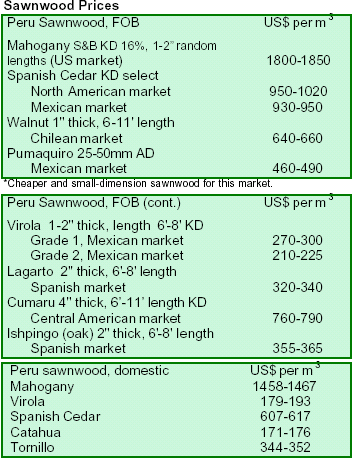
9. BOLIVIA
Export of forest products surge to new record
Bolivia's exports of forest products surged to $164 million in 2005, growing at an average annual rate of
17.5% over the last four years (see chart). Exports of these products were 13% up from 2004. Exports of
non-timber forest products had been the main driver of the export growth. In 2005, exports of these products
($81.8 million) almost matched the export level of wood products ($82.2 million) for the first time (49.9% share,
up from 40% in 1998). Processed Brazilian nuts (91%) and palm heart (9%) were the most important non-timber
forest products.
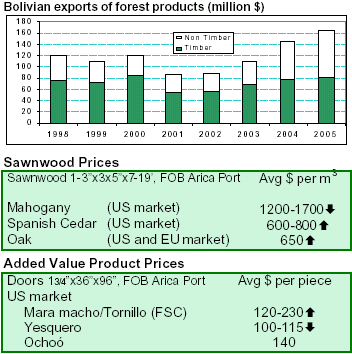
10. Guatemala
India continues taking
Guatemala's teak exports
Exports of sawnwood and log teak went entirely to the Indian market in May 2006. Average prices for these
products increased 1.6% and 1.3% to $250 and $460 per m3, respectively from the previous month. The export
volume, however, fell 19% to 173 m3 from April 2006.

11.
Guyana
Exports of bulletwood gain momentum///////////////////////////////////
Exports of wood products from Guyana remain strong in spite of the current rainy season that is slowing
production down. Greenheart continues to be the main export species both in log and sawn lumber forms,
followed by purpleheart and mora. Remarkably, bulletwood (macaranduba) logs have surged to the fourth
position in terms of volume while monkey pot (sapucaia) has taken the fifth position. Exports of sawn bulletwood
are also gaining momentum and are expected to climb sharply in the coming months together with darina
(angelim pedra) and tonka bean (cumaru).

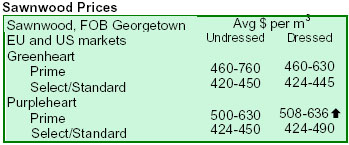
|